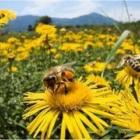You are here
» » Climate Change and the Pollination Problem
Climate Change and the Pollination Problem
Pollinators provide essential ecosystem services for our planet, but they are not immune to the effects of climate change. In fact, pollinator numbers have been dropping in recent years, directly reflecting major habitat alterations as a result of our changing climate.
More than three-quarters of Earth’s flora, including the majority of our food crops, rely on birds, insects, bats and other animals for reproduction to successfully occur. Studies have found that 87% of fruit, vegetable and seed production (35% of global food) depend on animal pollination.
Pollinators come in many different shapes and sizes and morphological characteristics will dictate which pollinator-plant pairs are able to effectively cross-fertilize. Honeybees, for example, are generalist pollinators that can feed on most plants due to their unique morphologies that allow them to “fit” with different species, and therefore provide pollination for a wide range of flora. Because of this unique characteristic, honeybees are responsible for pollinating over 90 commercially grown crops in North America. This makes them one of the most important insects in our food system.
Read more

